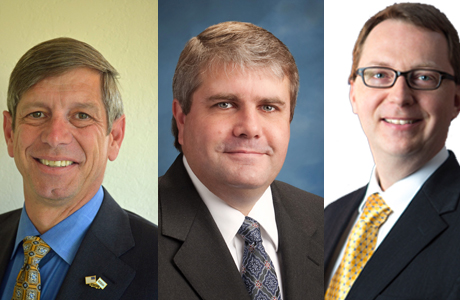Election results on Tuesday provided a firm rebuke to the politics of insanity that has recently become standard in Sunnyvale. The election of Gustav Larsson, Jim Griffith and Glenn Hendricks means the mentally and emotionally challenged—and recently censured Councilmember Patrick Meyering—will have no allies on the local governing body. That is a good thing.
Voters sometimes make mistakes but Sunnyvale voters were quick to recognize what they don’t like on their city council. Just as importantly, they passed a gun control ordinance overwhelmingly in spite of a heavy push by the National Rifle Association to defeat it.
That said, the NRA effort was impressive. But even in a small turn-out election, there are not enough gun nuts in Sunnyvale to stop reasonable restrictions on guns. Sunnyvale is not Wyoming.
Sunnyvale also changed its election cycle to ensure a higher turn-out of voters in the future. Small turn-out elections allow groups like the Tea Party to disproportionately influence elections. Less than 25 percent of voters showed up on Tuesday and that number portends a potential disaster for the public at large.
Consider that around 50 percent of the population can vote but is not registered. That means a 25 percent turn out represents only 12.5 percent of the voting population. As it only takes 50 percent of those voting to win, that means a motivated group of voters as low as 6.3 percent of the population determines the outcome of the election. That should frighten even the most apathetic voter.
Which brings us to Palo Alto. That city’s low turn-out produced a result that is embarrassing to a locale that prides itself on being educated, informed and socially active. Palo Alto rejected a 60-unit apartment complex for seniors based on a group of NIMBYs who voted based on their false fears.
As with all NIMBY groups, this one cited “traffic” as a major issue. The argument is specious. Sixty units of senior housing will not affect their traffic grid by a blip.
No this is elitism, bigotry—call it what you will—at its base. Those Palo Alto residents who were motivated don’t want “those” people in their neighborhood.
A small turnout allowed this small small-minded group to cast Palo Alto, a largely tolerant and progressive city, in a negative light.
A Mercury News editorial summed it up; “If Palo Alto residents won’t tolerate moderately dense housing for seniors, who will they build it for? It’s a disturbing question for a city that used to be viewed as progressive.”
Palo Alto could learn a good lesson from Sunnyvale.
Rich Robinson is a political consultant in Silicon Valley.


I’ll take Palo Alto’s “NIMBY”ism over San Jose’s apathy any day. Just look around at all the hideous apartment complexes and shopping centers that are being inflicted on us in the name of “progressivism”.
“But at least we’re not NIMBYs!”, we congratulate ourselves as we sink into the squalor.
I’m not quite sure of what your definition of “progressivism” is, but unlike yourself and the neighbors in Palo Alto, I think the will of the free market is best in determining land use.
I too believe in the will of the free market. But within a planning and zoning framework that has a beautiful, liveable City as it’s goal, not zoning and planning that’s primary function is to satisfy progressive ideals- especially the belief that it’s every city’s responsibility to provide as much affordable housing as there’s demand for.
The truth is, there’s unlimited demand for affordable housing. So by abdicating our responsibility to guide our own destiny, instead entrusting our planning to progressive, egghead, idealistic career politicians, the people are effectively dooming San Jose to be a city designed by and for developers.
No, I understand. You’re like many people who beleive in the will of the free market, so long as it produces an outcome you agree with.
No. If there’s one thing that I’m sure of it’s that you do NOT understand.
Understanding requires paying attention.